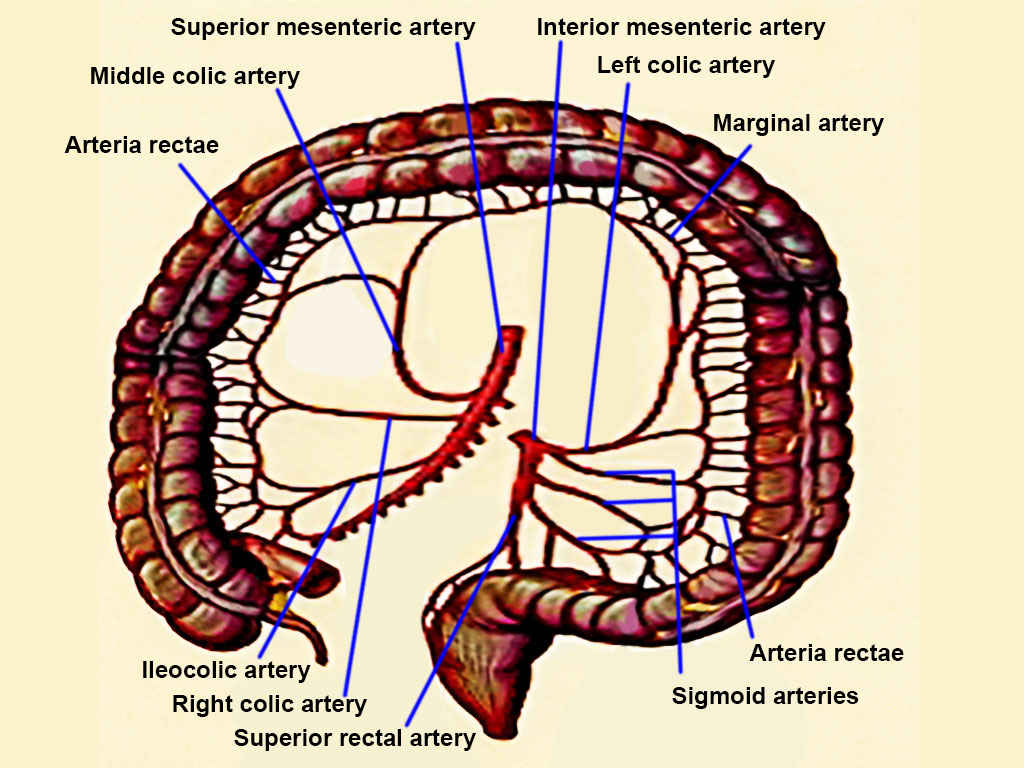[2]
Dumont F, Da Re C, Goéré D, Honoré C, Elias D. Options and outcome for reconstruction after extended left hemicolectomy. Colorectal disease : the official journal of the Association of Coloproctology of Great Britain and Ireland. 2013 Jun:15(6):747-54. doi: 10.1111/codi.12136. Epub
[PubMed PMID: 23398679]
[3]
Smereczyński A, Kołaczyk K. Pitfalls in ultrasound imaging of the stomach and the intestines. Journal of ultrasonography. 2018:18(74):207-211. doi: 10.15557/JoU.2018.0031. Epub
[PubMed PMID: 30451403]
[4]
Bruzzi M, M'harzi L, Poghosyan T, Ben Abdallah I, Papadimitriou A, Ragot E, El Batti S, Balaya V, Taieb J, Chevallier JM, Douard R. Arterial vascularization of the right colon with implications for surgery. Surgical and radiologic anatomy : SRA. 2020 Apr:42(4):429-435. doi: 10.1007/s00276-019-02359-9. Epub 2019 Oct 21
[PubMed PMID: 31637473]
[5]
GRIFFITHS JD. Surgical anatomy of the blood supply of the distal colon. Annals of the Royal College of Surgeons of England. 1956 Oct:19(4):241-56
[PubMed PMID: 13363265]
[6]
Harkins JM, Ahmad B. Anatomy, Abdomen and Pelvis, Portal Venous System (Hepatic Portal System). StatPearls. 2024 Jan:():
[PubMed PMID: 32119476]
[7]
Macina S, Imperatore M, Feleppa C, Sucameli F, Talamo G, Falco E, Berti S. Side-to-Side Anastomosis In Left Hemicolectomy, Why and When: A Single-Center Experience. Surgical technology international. 2019 May 15:34():183-186
[PubMed PMID: 30574685]
[8]
Strey CW, Wullstein C, Adamina M, Agha A, Aselmann H, Becker T, Grützmann R, Kneist W, Maak M, Mann B, Moesta KT, Runkel N, Schafmayer C, Türler A, Wedel T, Benz S. Laparoscopic right hemicolectomy with CME: standardization using the "critical view" concept. Surgical endoscopy. 2018 Dec:32(12):5021-5030. doi: 10.1007/s00464-018-6267-0. Epub 2018 Oct 15
[PubMed PMID: 30324463]
[9]
Gravante G, Elshaer M, Parker R, Mogekwu AC, Drake B, Aboelkassem A, Rahman EU, Sorge R, Alhammali T, Gardiner K, Al-Hamali S, Rashed M, Kelkar A, Agarwal R, El-Rabaa S. Extended right hemicolectomy and left hemicolectomy for colorectal cancers between the distal transverse and proximal descending colon. Annals of the Royal College of Surgeons of England. 2016 May:98(5):303-7. doi: 10.1308/rcsann.2016.0112. Epub 2016 Mar 29
[PubMed PMID: 27023638]
[10]
Tiberi A, Pesi B, Giudici F, Zambonin D, Nelli T, Cupellini C, Ficari F, Cianchi F, Scaringi S. Laparoscopic ileo-colic resection and right hemicolectomy for Crohn's disease and colon cancer: a preliminary comparative study on post-operative outcome. Updates in surgery. 2020 Sep:72(3):821-826. doi: 10.1007/s13304-020-00769-8. Epub 2020 Apr 18
[PubMed PMID: 32306278]
Level 2 (mid-level) evidence
[11]
Dovzhanskiy DI, Hakimi M, Bischoff MS, Wieker CM, Hackert T, Böckler D. [Colonic ischemia after open and endovascular aortic surgery : Epidemiology, Risk Factors, Diagnosis And Therapy]. Der Chirurg; Zeitschrift fur alle Gebiete der operativen Medizen. 2020 Feb:91(2):169-178. doi: 10.1007/s00104-020-01113-x. Epub
[PubMed PMID: 32002560]
[13]
Ruscelli P, Renzi C, Polistena A, Sanguinetti A, Avenia N, Popivanov G, Cirocchi R, Lancia M, Gioia S, Tabola R. Clinical signs of retroperitoneal abscess from colonic perforation: Two case reports and literature review. Medicine. 2018 Nov:97(45):e13176. doi: 10.1097/MD.0000000000013176. Epub
[PubMed PMID: 30407351]
Level 3 (low-level) evidence

